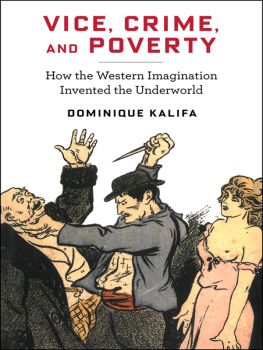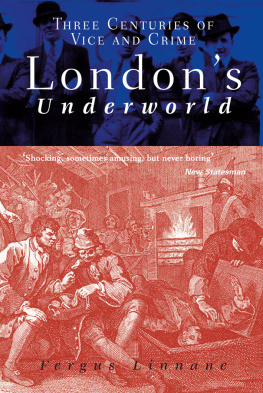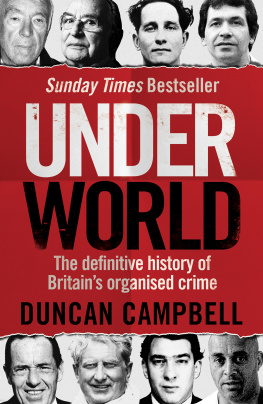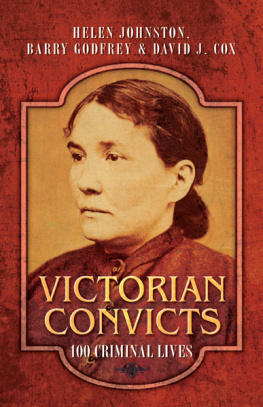Table of Contents
Vice, Crime, and Poverty
European Perspectives
European Perspectives
A Series in Social Thought and Cultural Criticism
Lawrence D. Kritzman, Editor
European Perspectives presents outstanding books by leading European thinkers. With both classic and contemporary works, the series aims to shape the major intellectual controversies of our day and to facilitate the tasks of historical understanding.
For a complete list of books in the series, see .
Vice, Crime, and Poverty
How the Western Imagination Invented the Underworld
Dominique Kalifa
Translated by
Susan Emanuel
Foreword by
Sarah Maza
Columbia University Press New York
Columbia University Press gratefully acknowledges the generous contribution for this book provided by Publishers Circle member Jeanine Plottel.
This work received the French Voices Award for excellence in publication and translation. French Voices is a program created and funded by the French Embassy in the United States and FACE Foundation (French American Cultural Exchange).
Columbia University Press
Publishers Since 1893
New York Chichester, West Sussex
cup.columbia.edu
First published in French as Les Bas-fonds: Histoire dun imaginaire
2013 Editions du Seuil
English translation copyright 2019 Columbia University Press
All rights reserved
E-ISBN 978-0-231-54726-0
Library of Congress Cataloging-in-Publication Data
Names: Kalifa, Dominique, author. | Emanuel, Susan, translator.
Title: Vice, crime and poverty: how the Western imagination invented the underworld / Dominique Kalifa; translated by Susan Emanuel.
Other titles: Bas-fonds. English
Description: New York: Columbia University Press, [2019] | Series: European perspectives | Translation of: Bas-fonds. | Includes bibliographical references and index.
Identifiers: LCCN 2018042782 (print) | LCCN 2018051325 (e-book) | ISBN 9780231547260 (e-book) | ISBN 9780231187428 (cloth: alk. paper)
Subjects: LCSH: Urban poorHistory. | Marginality, Social. | Marginality, Social, in literature. | CriminalsHistory. | Criminals in literature. | Inner citiesHistory. | CrimeHistory. | Inner cities in literature. | Social representations. | Deviant behavior in literature.
Classification: LCC HV6963 (e-book) | LCC HV6963 .K347 2019 (print) | DDC 305.5/69091732dc23
LC record available at https://lccn.loc.gov/2018042782
A Columbia University Press E-book.
CUP would be pleased to hear about your reading experience with this e-book at .
Cover design: Julia Kushnirsky
Cover image: originally appeared on the cover of Les Bas-fonds du crime et de la prostitution by Mr. Jean (Paris: P. Fort, 1901). Collection Kharbine-Tapabor.
For Alain Corbin
Contents
Several chapters in this book, in earlier versions, were given as papers and lectures. My thanks go to many colleagues who gave me the opportunity to discuss some aspects of this work: Lise Andris at the Universit Paris-Sorbonne; Lucia Granja at the University of Sao Paulo in Rio Preto; J.-P. Daughton at Stanford University; Cathy Nesci and Dominique Julien at the University of California at Santa Barbara; Daryl Lee, Corry Cropper, and students at Brigham Young University, who participated in a seminar on this subject; Michel Porret at Geneva University; Corinne Legoy at the University of Orlans; Walburga Hlk-Althoff at the University of Essen; Robin Walz, Sarah Maza, and Miranda Spieler, who organized a session at the Western Society for French History at the University of Louisiana at Lafayette; Andrea Goulet and the Nineteenth-Century Society for French Studies; Jann Matlock at University College London; Laure Murat at the University of California at Los Angeles; Andrew Pepper and Dominique Jeannerod at Queens University, Belfast; Alex Gagnon and Pierre Hbert at Sherbrooke University; Vanessa Schwartz at the University of Southern California; Laura Suarez de la Torre at the Instituto Mora, Mexico; Guillaume Pinson at Laval University, Qubec; Maire Cross and Steve Wharton at Bath University; Marta Caraion at Lausanne University; Deivy Carneiro Ferreira at the Uberlandia University, Brazil.
Other aspects of this book have been subjects I have taught in courses and a cycle of seminars at the Universit PanthonSorbonne. My thanks also go to the students who attended them, and whose suggestions and research papers enabled me to deepen several points. A special mention goes to Louise Auvitu, Camille Boucher, Emilie Braga, Damien Cailloux, Corinne Doria, Laure Dubesset, Fabienne Giuliani, Lucia Katz, Agathe Lecoeur, Mathilde Meheust, Hadrien Nouvelot, Marie-Charlotte Parpaite, Nicolas Picard, Alicia Potin, and Jrme Triebel.
Many colleagues and students gave me the benefit of their erudition or have transmitted documents to me. So thanks to Marcos Bretas, Lila Caimari, Leonardo Carvalho-Goncalves, Jean-Claude Caron, Jacques Carr, Glenn Close, Stphanie Demange, Mlodie Simard-Houde, Laura OBrien, Michel Porret, Jean-Nol Tardy, and Jean-Claude Vimont.
I also wish to thank Alberto Gabriele for introducing me to Gladstone Library, and my editors at Le Seuil, Hughes Jallon and Severine Nikel, who had trust in this project.
Obtaining the French Voices Award in 2016 greatly facilitated the translation of this book into English. Therefore, my thanks go to the Cultural Services of the French Embassy, as well as to American colleagues and friends who helped me in this enterprise: Venitta Data Stephane Gerson, Robin Holding, Philip Nord, and John Merriman. Larry Kritzman and Jennifer Crewe agreed with enthusiasm to publish this book in this collection, and Susan Emanuel devoted her knowledgeand her patiencein offering a magnificent translation.
In 1958, Louis Chevalier published his Laboring Classes and Dangerous Classes, a book that instantly became a classic whose influence has endured to this day. A study of urban change and poverty in Paris in the first half of the nineteenth century, its lasting impact came from Chevaliers unprecedented and unorthodox mixing of sources. Alongside the classic materials of urban history such as administrative and demographic sources, Chevalier also drew upon a range of literary texts, from the canonical such as novels by Balzac and Hugo to serials and other pulp fictions. These works were not to be used as documentary evidence, he argued; rather, they provided a way of understanding the terrors the Parisian middle classes experienced in response to the dramatic post-revolutionary swelling of the capitals poorer population. Victor Hugos hallucinatory depiction of the citys sewers in Les Misrables, for instance, tells us less about urban sanitation than about fears of a dark and dangerous world below the streets, a metaphor for the unknown hordes of the angry poor. Inserting fiction as fiction into his analysis, Chevalier pioneered for historians what has since become known as the study of the social imaginary.
Dominique Kalifa, whose work, especially in the present volume, has addressed some of the same themes as Chevaliers, is todays leading historian in France of the social imaginary. If Chevaliers legacy haunts













